Mechanism of and Prevention Technology for Water Inrush from Coal Seam Floor under Complex Structural Conditions—A Case Study of the Chensilou Mine
Abstract
:1. Introduction
2. Project Overview
3. Numerical Simulation of Water Inrush Mechanism from Coal Seam Floor
3.1. Software Introduction and Model Establishment
3.2. Analysis of Vertical Stress Evolution Characteristics
3.3. Analysis of Displacement Evolution Characteristics
3.4. Analysis of Fracture Evolution Characteristics
3.5. Evolution Characteristics of Plastic Zone and Seepage Analysis
4. Numerical Simulation of Grouting in Coal Seam Floor
4.1. Model Establishment
4.2. Diffusion Law of L10 Grouting Slurry
4.3. Diffusion Law of L8 Grouting Slurry
5. Engineering Applications
5.1. Grouting Plan
5.2. Effect Verification
5.2.1. Geophysical Verification
5.2.2. Drilling Verification
6. Conclusions
- (1)
- The analysis of our on-site data shows that due to the influence of faults, hidden cracks, and water pressure, the upper part of the Taiyuan Formation aquifer in the Chensilou sixth mining area may have hydraulic connections with the Ordovician limestone aquifer, resulting in complex hydrogeological conditions in the mine. Among them, L10 and L8 are the main aquifers, with well-developed dissolution fractures.
- (2)
- As coal is mined, the vertical stress within the roof and floor of the mining area is redistributed, resulting in a concentration of stress in the coal and rock at both ends of the goaf, with a symmetrical distribution on both sides. A pressure relief zone was created within the roof and floor, causing it to move towards the goaf and form a certain degree of floor heave. During the movement process, a large number of open cracks and sliding cracks are generated in the roof and floor, causing plastic damage to the floor. After the activation of hidden faults and cracks, a water inrush channel on the floor is formed, causing water accidents in the working face. The numerical simulation results are consistent with the on-site water inrush situation, which can provide a basis for the effective transformation measures of the floor under complex hydrogeological conditions.
- (3)
- The grouting effect varies at different layers and pressures. For the 2601 working face of the Chensilou mine, when the L10 thin limestone is selected as the injection layer, the injection range gradually increases with the increase in injection pressure. However, an excessive injection pressure can easily cause slurry leakages and resource waste in the working face. Choosing a reasonable injection pressure is crucial. When the lower layer of the L8 thin limestone is selected for the injection layer, the diffusion law of the slurry is consistent with that of L10, but the injection pressure cannot be too small. If it is too small, the grouting reconstruction effect will not be obvious.
- (4)
- A geophysical verification of the effect of the reconstruction of the grouting was conducted underground using transient electromagnetic and three-dimensional direct-current resistivity methods. It indicates that the apparent resistivity of the coal seam floor after the treatment is relatively high, and there are only low-resistivity abnormal areas with a resistivity less than 12 Ω·m within the range of 280 m–360 m along the working face direction and 80 m–170 m towards the working face. However, there was no water outflow in the borehole, indicating that the aquifer’s fissure water storage space was filled and reinforced with slurry. Our use of ground regional advanced governance projects achieved significant results.
- (5)
- The research results have a certain value which is of theoretical and practical significance and can provide a reference for water hazard management in similar mines. Before grouting, the floor structure and the development of floor cracks during mining should be fully understood, and the possible water inrush channels should be identified. When grouting, an appropriate grouting layer and grouting pressure should be selected according to the actual situation of the site to avoid the phenomenon in which the grouting pressure is too large to cause the working face to run slurry or the grouting pressure is too small to diminish the transformation effect.
Author Contributions
Funding
Data Availability Statement
Conflicts of Interest
References
- Liu, W.T.; Wu, Q. Mechanism and Numerical Simulation Technology of Lagging Water Inrush in Deep Mining; Coal Industry Publishing House: Beijing, China, 2010; pp. 2–5. [Google Scholar]
- Zhang, W.Q.; Yang, C.G.; Jiang, P.W.; Zhang, H.R.; Kong, L.Z. Prevention and Control of Mine Water Disaster; China University of Mining and Technology Press: Xuzhou, China, 2008; pp. 20–80. [Google Scholar]
- Yubing, G.A.O.; Shiqi, L.I.U.; Bin, L.Y.U.; Kunqi, L.I. Mechanism study of floor water inrush around mining field based on micro-crack extension. J. Min. Saf. Eng. 2016, 33, 624–629. [Google Scholar]
- Li, L.C.; Tang, C.A.; Li, G.; Yang, T.H. Damage evolution and delayed groundwater inrush from micro faults in coal seam floor. Chin. J. Geotech. Eng. 2009, 31, 1838–1844. [Google Scholar]
- Zhao, J.W.; Zhou, H.W.; Xue, D.J.; Su, T.; Deng, H.L.; Yang, H.Z. Expansion law of seepage path in the concealed structural floor of coal seam in deep confined water. J. China Coal Soc. 2019, 44, 1836–1845. [Google Scholar]
- Pan, Y.B. An inquiry of secure hydraulic head formula of slisalif’s. J. Hefei Polytech. Univ. 1986, 8, 99–103. [Google Scholar]
- Li, B.Y. “Down three zones” in the prediction of the water inrush from coalbed floor aquifer-theory, development and application. J. Shandong Inst. Min. Technol. 1999, 18, 11–18. [Google Scholar]
- Liu, Q.S. A discussion on water inrush coefficient. Coal Geol. Explor. 2009, 37, 34–37. [Google Scholar]
- Wang, J.T.; Wang, X.L. Discussion on water inrush coefficient method applied to predict water inrush danger of seam floor. Coal Sci. Technol. 2011, 39, 106–111. [Google Scholar]
- Zhang, J.C.; Zhang, Y.Z.; Liu, T.Q. Rock Seepage and Water Inrush of Seam Floor; Geological Press: Beijing, China, 1997. [Google Scholar]
- Xing, Z.G.; Li, B.Y. Mechanism of water inrush in coal seam floor. Coal Geol. Explor. 1980, 2, 27–29. [Google Scholar]
- Li, B.Y.; Er, S.Z. Mining Engineering Hydrogeology; Shandong Institute of Mining and Technology Press: Tai’an, China, 1988. [Google Scholar]
- Wang, Z.Y.; Liu, H.Q. Coal Mining above Confined Aquifer; Coal Industry Press: Beijing, China, 1992. [Google Scholar]
- Qian, M.G.; Miao, X.X.; Xu, J.L. Theoretical study of key stratum in ground control. J. China Coal Soc. 1996, 21, 225–230. [Google Scholar]
- Hu, X.; Wang, L.; Lu, Y.; Yu, M. Analysis of insidious fault activation and water inrush from the mining floor. Int. J. Min. Sci. Technol. 2014, 24, 477–483. [Google Scholar] [CrossRef]
- Peng, S.P.; Meng, Z.P.; Li, Y.L. Influence of faults on coal roof stability by physical modeling study. Coal Geol. Explor. 2001, 29, 1–4. [Google Scholar]
- Zuo, J.P.; Chen, Z.H.; Wang, H.W.; Liu, X.P.; Wu, Z.P. Experimental investigation on fault activation pattern under deep mining. J. China Coal Soc. 2009, 34, 305–309. [Google Scholar]
- Li, Z.H.; Dou, L.M.; Lu, Z.Y.; Lu, X.W.; Wang, G.R. Study of the fault slide destabilization induced by coal mining. J. Min. Saf. Eng. 2010, 27, 499–504. [Google Scholar]
- Li, K.; Mao, X.B.; Chen, L.; Zhang, L.Y. Research on fault activation and risk analysis of water inrush in mining floor above confined aquifer. Chin. Q. Mech. 2011, 32, 261–268. [Google Scholar]
- Liu, Z.J.; Hu, Y.Q. Solid-liquid coupling study on water inrush through faults in coal mining above confined aquifer. J. China Coal Soc. 2007, 32, 1046–1050. [Google Scholar]
- Zheng, S.H.; Zhu, W.S.; Wang, S.F. Study on the coupling problem between flow and solid of mine in confined aquifer. Chin. J. Rock Mech. Eng. 2000, 19, 421–424. [Google Scholar] [CrossRef]
- Zhang, P.; Yan, W.; Zhang, W.; Wang, H. Experimental research on fault activation and water inrush induced by mining under solid-liquid coupling mode. Saf. Coal Mines 2014, 45, 24–27. [Google Scholar]
- Zhang, P.; Yan, W.; Zhang, W.; Wang, H. Analysis of Water Inrush Disaster Mechanism of Inter-Layer Rocks between Close Coal Seams under the Influence of Mining. Appl. Sci. 2023, 13, 9043. [Google Scholar] [CrossRef]
- Liu, Y.; Liu, S.; Huo, Z.; Sun, K.; Wang, T.; Li, W. Failure Characteristics of Coal Seam Floor and Risk Assessment of Water Inrush Caused by Underground Coal Mining. Energy Explor. Exploit. 2023, 41, 677–695. [Google Scholar] [CrossRef]
- Yang, T.H.; Tang, C.A.; Xu, T. Flow Characteristics during Rock Failure Process-Theory, Models and Applications; Science Press: Beijing, China, 2004. [Google Scholar]
- Yang, T.H.; Liu, J.; Zhu, W.C.; Elsworth, D.; Tham, L.G.; Tang, C.A. A coupled flow-stress-damage model for groundwater outbursts from an underlying aquifer into mining excavations. Int. J. Rock Mech. Min. Sci. 2007, 44, 87–97. [Google Scholar] [CrossRef]
- Song, W.; Liang, Z. Theoretical and numerical investigations on mining-induced fault activation and groundwater outburst of coal seam floor. Bull. Eng. Geol. Environ. 2021, 80, 5757–5768. [Google Scholar] [CrossRef]
- Yin, H.; Sang, S.; Xie, D.; Zhao, H.; Li, S.; Li, H.; Zhuang, X. A numerical simulation technique to study fault activation characteristics during mining between fault bundles. Environ. Earth Sci. 2019, 78, 1–11. [Google Scholar] [CrossRef]
- Xin, C.; Jiang, F.; Zhai, C.; Chen, Y. Analysis of Coal Floor Fault Activation Inducing Water Inrush Using Microseismic Monitoring—A Case Study in Zhaogu No. 1 Coal Mine of Henan Province, China. Sustainability 2023, 15, 7361. [Google Scholar] [CrossRef]
- Hu, Y.; Sun, J.; Liu, W.; Wei, D. The evolution and prevention of water inrush due to fault activation at working face no. II 632 in the Hengyuan coal mine. Mine Water Environ. 2019, 38, 93–103. [Google Scholar] [CrossRef]
- Li, H.; Bai, H. Simulation research on the mechanism of water inrush from fractured floor under the dynamic load induced by roof caving: Taking the Xinji Second Coal Mine as an example. Arab. J. Geosci. 2019, 12, 1–24. [Google Scholar] [CrossRef]
- Yu, H.; Zhu, S.; Xie, H.; Hou, J. Numerical simulation of water inrush in fault zone considering seepage paths. Nat. Hazards 2020, 104, 1763–1779. [Google Scholar] [CrossRef]
- Itasca. UDEC, Version 6.0; Itasca Consulting Group Inc.: Minneapolis, MN, USA, 2014.





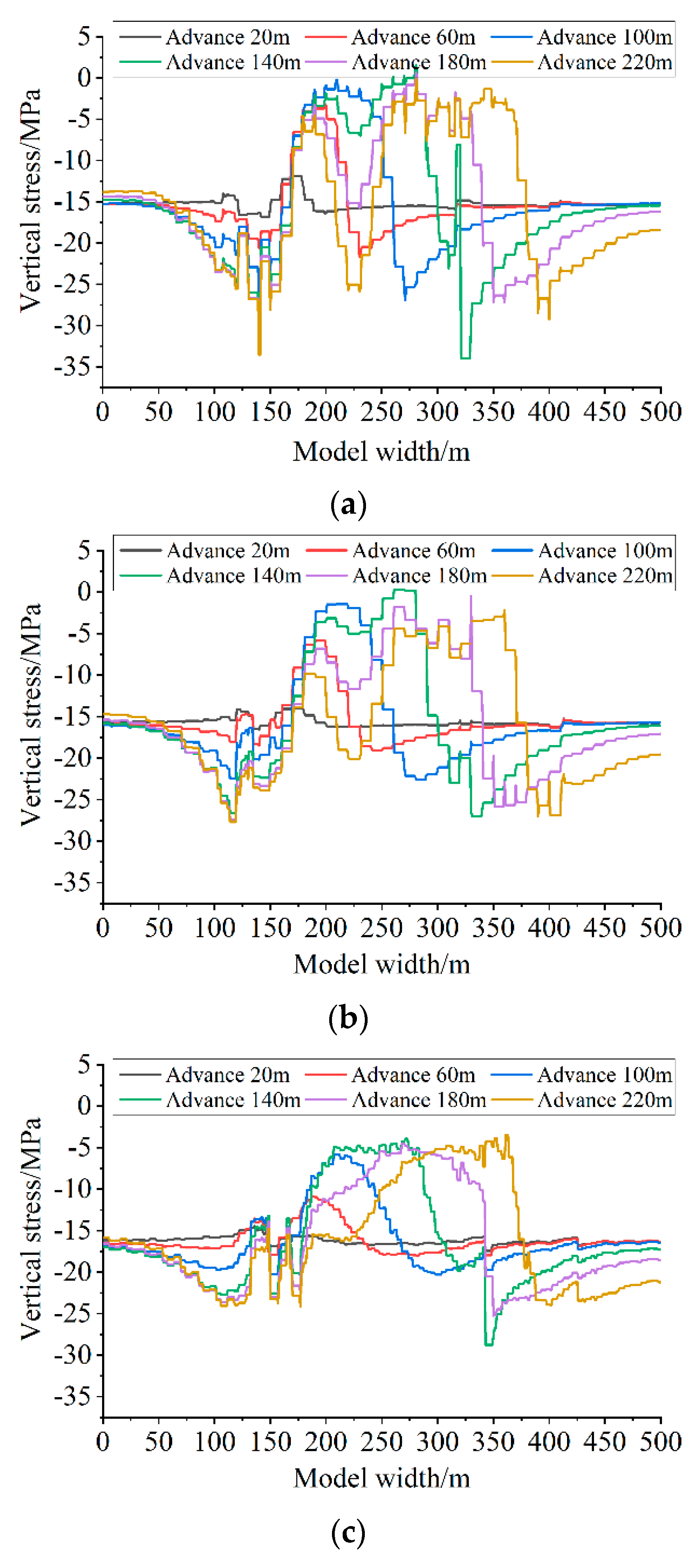
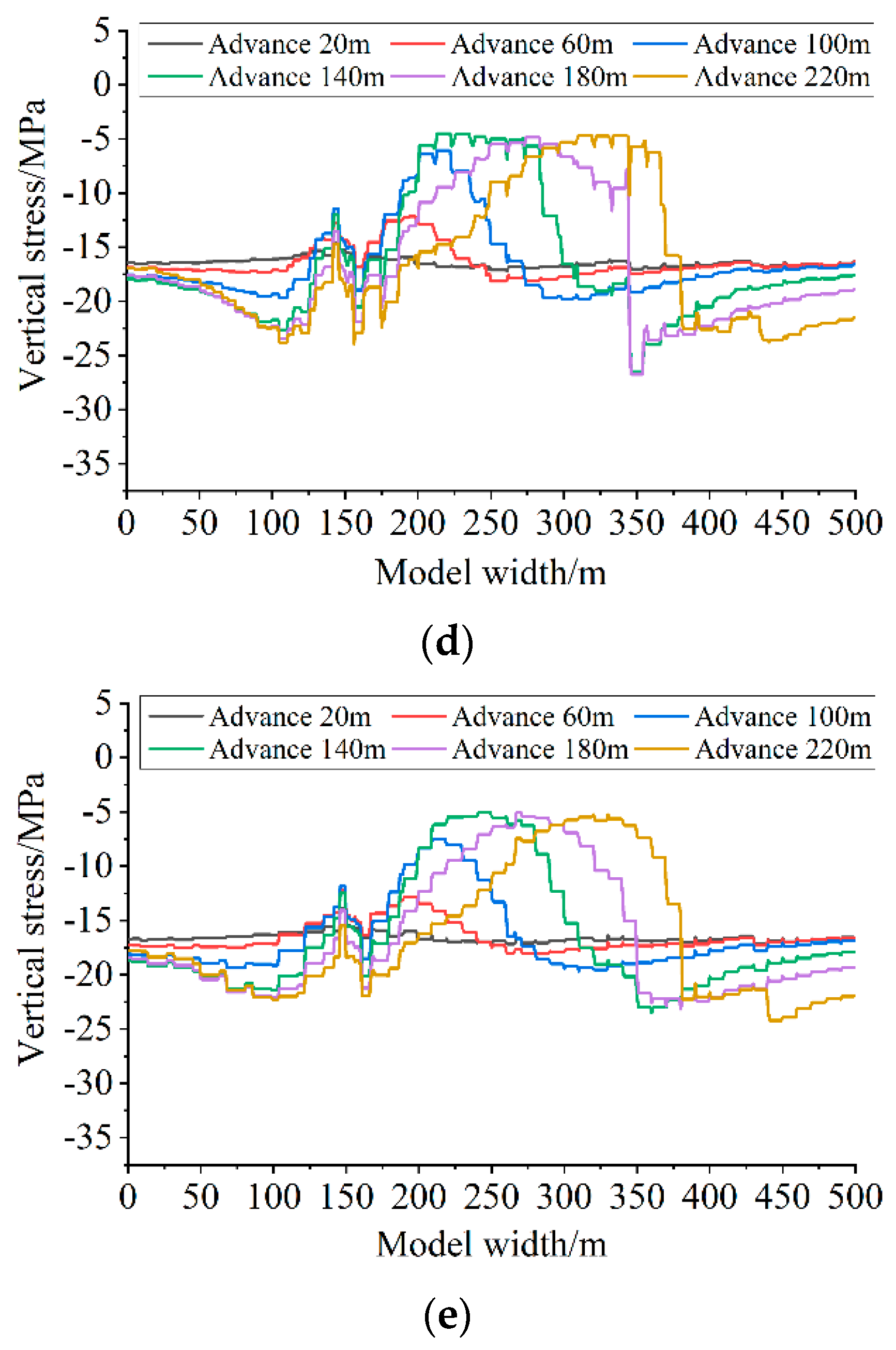


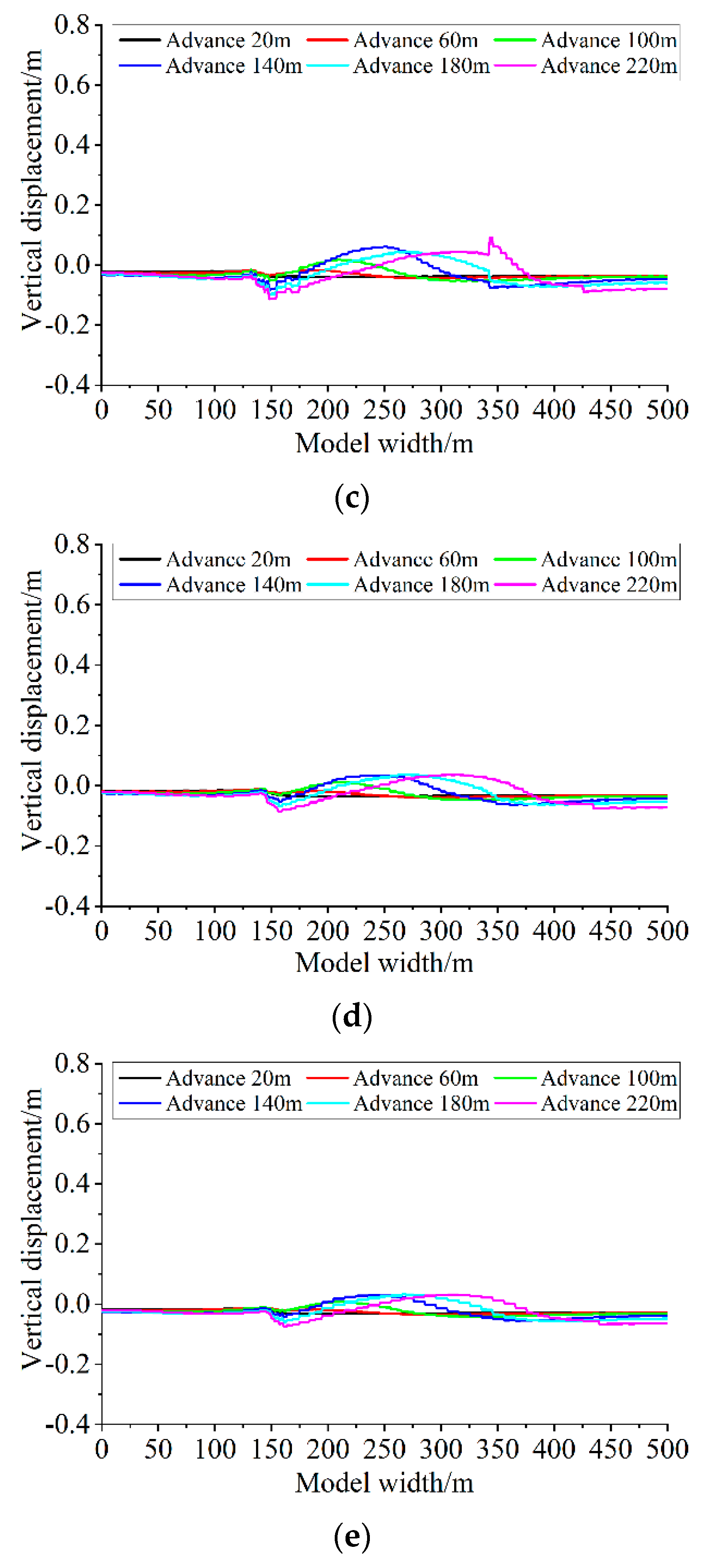
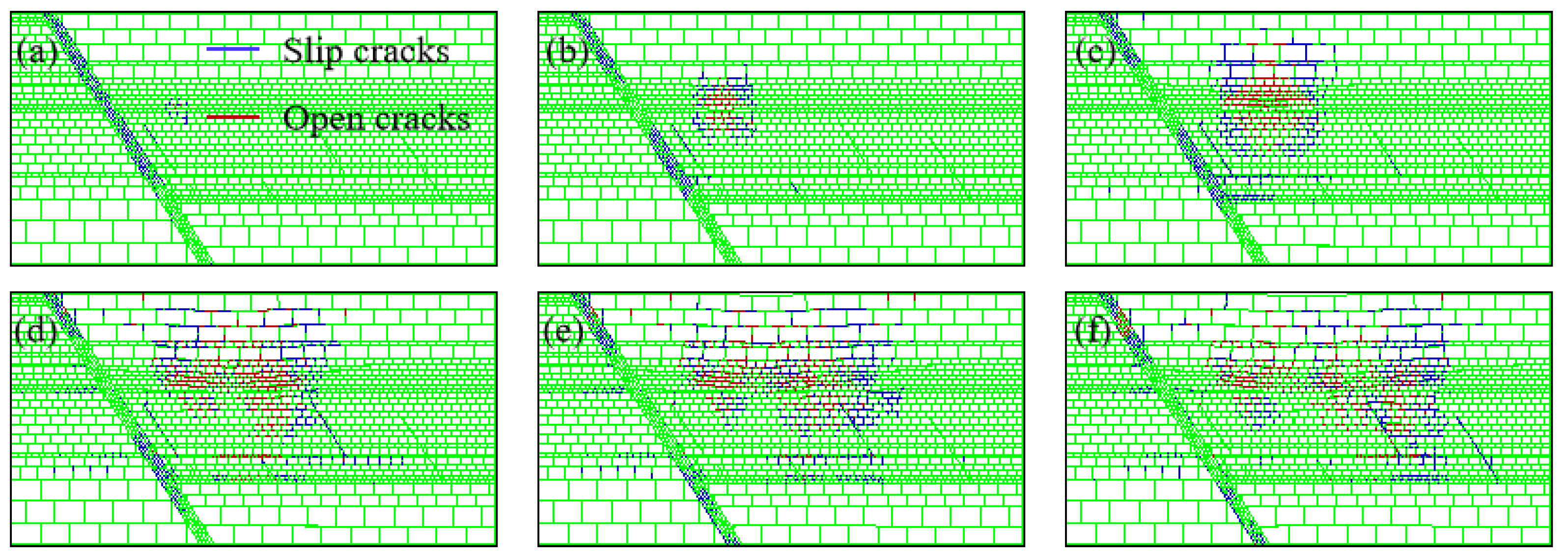

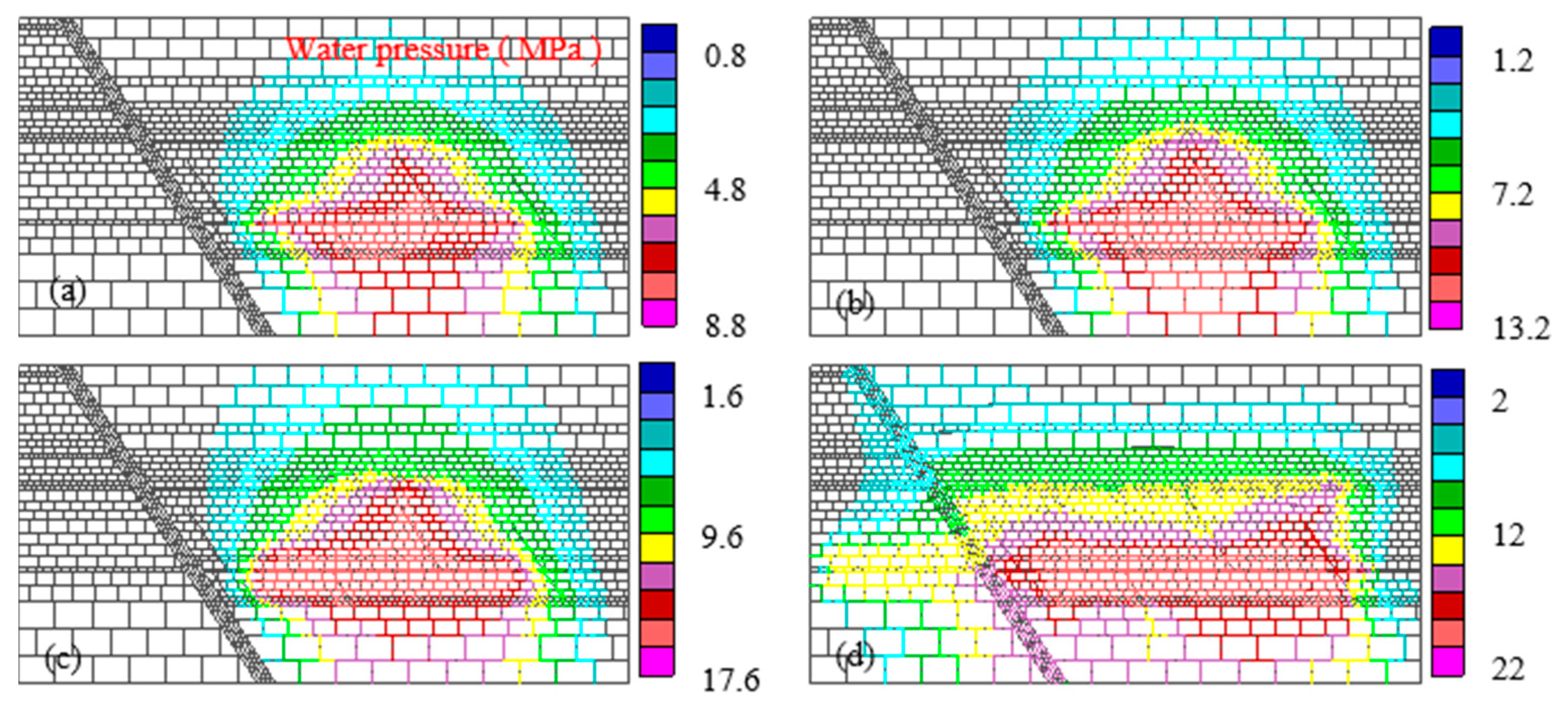



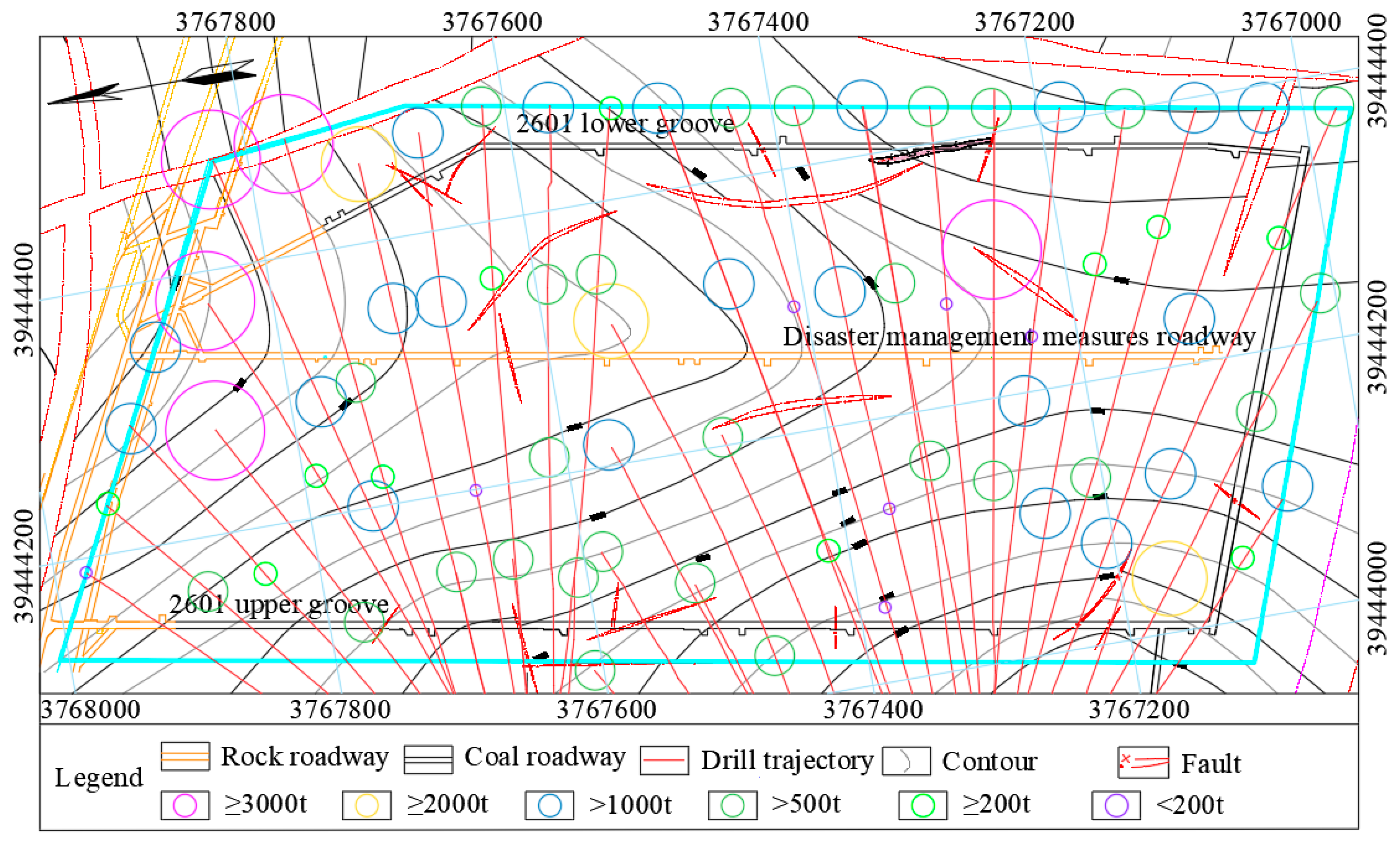

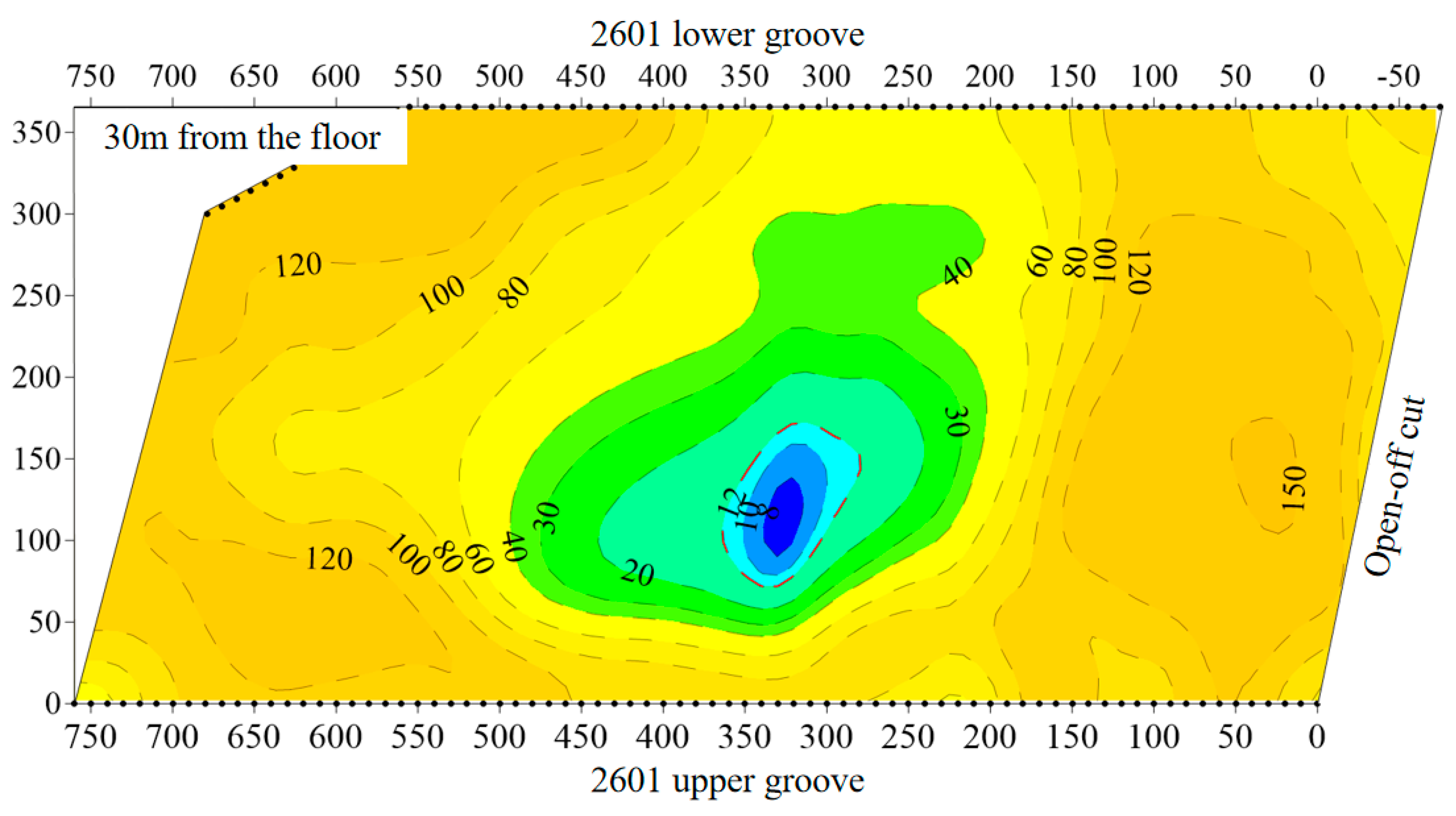
| Number | Lithology | Density (kg/m3) | Bulk Modulus (kPa) | Shear Modulus (kPa) | Cohesion (kPa) | Tensile Strength (kPa) | Friction Angle (°) |
|---|---|---|---|---|---|---|---|
| 1 | Mudstone | 2300 | 10 × 106 | 7 × 106 | 3.2 × 103 | 2.4 × 103 | 25 |
| 2 | Coal | 1300 | 7 × 106 | 4 × 106 | 1.2 × 103 | 1.5 × 103 | 22 |
| 3 | Fine sandstone | 2500 | 15 × 106 | 11 × 106 | 2.8 × 103 | 3.1 × 103 | 30 |
| 4 | Siltstone | 2300 | 13 × 106 | 9 × 106 | 3.4 × 103 | 2.6 × 103 | 26 |
| 5 | Sandy mudstone | 2400 | 11 × 106 | 7 × 106 | 2.7 × 103 | 3.3 × 103 | 32 |
| 6 | L10, L8, L3, L2 | 2400 | 15 × 106 | 8 × 106 | 3.3 × 103 | 2.9 × 103 | 32 |
| 7 | Ordovician limestone | 2500 | 20 × 106 | 12 × 106 | 3.6 × 103 | 3.2 × 103 | 35 |
| 8 | Fault | 900 | 4 × 106 | 2 × 106 | 1.8 × 103 | 0.8 × 103 | 26 |
| Number | Joint Type | Normal Stiffness (kPa/m) | Tangential Stiffness (kPa/m) | Friction Angle (°) | Cohesion (kPa) | Permeability Constant (Pa−1·s−1) | Initial Gap Width (m) | Residual Gap Width (m) |
|---|---|---|---|---|---|---|---|---|
| 1 | Mudstone | 3.5 × 106 | 1.5 × 106 | 26 | 0.05 × 103 | 30 | 1 × 10−3 | 0.5 × 10−3 |
| 2 | Coal | 2 × 106 | 1 × 106 | 15 | 0.1 × 103 | - | - | - |
| 3 | Fine sandstone | 3.3 × 106 | 1.4 × 106 | 21 | 1.0 × 103 | - | - | - |
| 4 | Siltstone | 5.4 × 106 | 2.2 × 106 | 32 | 0.7 × 103 | - | - | - |
| 5 | Sandy mudstone | 4 × 106 | 2 × 106 | 21 | 1.6 × 103 | - | - | - |
| 6 | L10, L8, L3, L2 | 12 × 106 | 6 × 106 | 15 | 0.1 × 103 | 30 | 0.1 × 10−3 | 0.05 × 10−3 |
| 7 | Ordovician limestone | 12 × 106 | 6 × 106 | 15 | 0.1 × 103 | 100 | 0.2 × 10−3 | 0.1 × 10−3 |
| 8 | Fault | 3.5 × 106 | 1.5 × 106 | 26 | 0.05 × 103 | 300 | 1 × 10−3 | 0.5 × 10−3 |
| 9 | Crack | 3.5 × 106 | 1.5 × 106 | 26 | 0.05 × 103 | 100 | 1 × 10−3 | 0.5 × 10−3 |
Disclaimer/Publisher’s Note: The statements, opinions and data contained in all publications are solely those of the individual author(s) and contributor(s) and not of MDPI and/or the editor(s). MDPI and/or the editor(s) disclaim responsibility for any injury to people or property resulting from any ideas, methods, instructions or products referred to in the content. |
© 2023 by the authors. Licensee MDPI, Basel, Switzerland. This article is an open access article distributed under the terms and conditions of the Creative Commons Attribution (CC BY) license (https://creativecommons.org/licenses/by/4.0/).
Share and Cite
Wang, Q.; Zheng, S.; Shi, Z.; Wu, P.; Lv, H.; Wang, G. Mechanism of and Prevention Technology for Water Inrush from Coal Seam Floor under Complex Structural Conditions—A Case Study of the Chensilou Mine. Processes 2023, 11, 3319. https://doi.org/10.3390/pr11123319
Wang Q, Zheng S, Shi Z, Wu P, Lv H, Wang G. Mechanism of and Prevention Technology for Water Inrush from Coal Seam Floor under Complex Structural Conditions—A Case Study of the Chensilou Mine. Processes. 2023; 11(12):3319. https://doi.org/10.3390/pr11123319
Chicago/Turabian StyleWang, Qi, Shitian Zheng, Zhiyuan Shi, Pei Wu, Huayong Lv, and Gang Wang. 2023. "Mechanism of and Prevention Technology for Water Inrush from Coal Seam Floor under Complex Structural Conditions—A Case Study of the Chensilou Mine" Processes 11, no. 12: 3319. https://doi.org/10.3390/pr11123319





